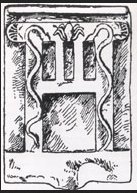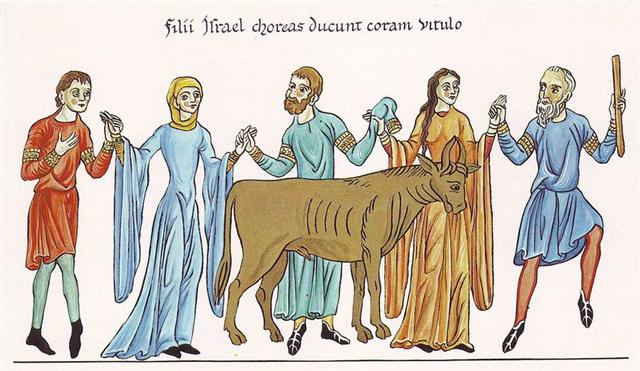Watching TV does give some knowledge. For instance was I told that modern science now had discovered that the scarab beetle had the unique ability to orient itself from the direction of the Milky Way. Surely, I thought, this must once upon a time had been well known (common knowledge).
... The water dots invite us to count, and one of several possible structures is:
22 is here needed in the 2nd group, but 46 + 22 = 68. The mountain top at left has zero, and this fact could mean we should add 16 + 22 + 14 in order to reach 52 (= 364 / 7) - with 22 as its center:
2 * 52 + 33 = 137 = 2 * 68 + one more ... = 68 + 69, cfr:
And then I happened to stumble on a report regarding the behaviour of chimpanzees, viz. how modern science slowly had begun to understand that they communicated not only vocally but also by signs. For instance, when the mother lifted up her foot so its underside became visible her offspring immediately understood that he should jump onto her back because it was time to move. And investigations into the cranium of Neanderthal man has eventually began to convince modern scientists that they indeed might have been capable of talking to each other. How stupid! All creatures have to be capable of communication by sound and other signs.
It is civilized man who has lost most of the ancient understanding: ... the equinoctial 'points' - and therefore, the solstitial ones, too - do not remain forever where they should in order to make celestial goings-on easier to understand, namely, at the same spot with respect to the sphere of the fixed stars. Instead, they stubbornly move along the ecliptic in the opposite direction to the yearly course of the sun, that is, against the 'right' sequence of the zodiacal signs (Taurus→Aries→Pisces, instead of Pisces→Aries→Taurus). This phenomenon is called the Precession of the Equinoxes, and it was conceived as causing the rise and the cataclysmic fall of ages of the world. Its cause is a bad habit of the axis of our globe, which turns around in the manner of a spinning top, its tip being in the center of our small earth-ball, whence our earth axis, prolonged to the celestial North Pole, describes a circle around the North Pole of the ecliptic, the true 'center' of the planetary system, the radius of this circle being of the same magnitude as the obliquity of the ecliptic with respect to the equator: 23 ½º. The time which this prolonged axis needs to circumscribe the ecliptical North Pole is roughly 26,000 years, during which period it points to one star after another: around 3000 B.C. the Pole star was alpha Draconis; at the time of the Greeks it was beta Ursae Minoris; for the time being it is alpha Ursae Minoris; in A.D. 14,000 it will be Vega. The equinoxes, the points of intersection of ecliptic and equator, swinging from the spinning axis of the earth, move with the same speed of 26,000 years along the ecliptic. The sun's position among the constellations at the vernal equinox was the pointer that indicated the 'hours' of the precessional cycle - very long hours indeed, the equinoctial sun occupying each zodiacal constellation for about 2,200 years. The constellation that rose in the east just before the sun (that is, rose heliacally) marked the 'place' where the sun rested. At this time it was known as the sun's 'carrier', and as the main 'pillar' of the sky, the vernal equinoxes being recognized as the fiducial point of the 'system', determining the first degree of the sun's yearly circle, and the first day of the year. (When we say, it was 'recognized', we mean that it was spelled 'carrier' or 'pillar', and the like: it must be kept in mind that we are dealing with a specific terminology, and not with vague and primitively rude 'beliefs'.) At Time Zero (say, 5000 B.C. - there are reasons for this approximate date), the sun was in Gemini; it moved ever so slowly from Gemini into Taurus, then Aries, then Pisces, which it still occupies and will for some centuries more. The advent of Christ the Fish marks our age. It was hailed by Virgil, shortly before Anno Domini: 'a new great order of centuries is now being born...' which earned Virgil the strange title of prophet of Christianity. The preceding age, that of Aries, had been heralded by Moses coming down from Mount Sinai as 'two-horned', that is, crowned with the Ram's horns, while his flock disobediently insisted upon dancing around the 'Golden Calf' that was, rather, a 'Golden Bull', Taurus ... Manuscript E and the rongorongo text were surely using special terminology. And presumably such signs were culturally inherited according to the rule of the survival of the fittest. A rule for all kinds of living. Anakena, I suspect, could have been derived from the same root as the ancient Greek Wanax: ... Anax ... is an ancient Greek word for '(tribal) king, lord, (military) leader'. It is one of the two Greek titles traditionally translated as 'king', the other being basileus. Anax is the more archaic term of the two, inherited from the Mycenaean period, and is notably used in Homeric Greek, e.g. of Agamemnon. The feminine form is ánassa, 'queen' (from wánakt-ja) ... ... The meaning of basileus as 'king' in Classical Greece is due to a shift in terminology during the Greek Dark Ages. In Mycenaean times, a gwasileus appears to be a lower-ranking official (in one instance a chief of a professional guild), while in Homer, Anax is already an archaic title, most suited to legendary heroes and gods rather than for contemporary kings. The Greek title has been compared to Sanskrit ... vanij, a word for 'merchant', but in the Rigveda once used as a title of Indra. The word could then be from PIE *wen-ag'-, roughly 'bringer of spoils' (compare the etymology of lord, 'giver of bread'). Archaic inscription (...)i wanakti, 'to the king', on [a}ceramic fragment, here shown upside down; a warrior bearing a spear and mounted on a horse is also depicted:
... The 'giver of bread' (Lord) should indicate the king who enters at the beginning of summer (through the Π door) and the 'bringer of spoils' (Anax) the other king who enters at the beginning of winter (through the underground Η door).  The ceramic fragment depicts the Lord King upside down - he has turned around from a 'cap' position to a 'cup', he has 'toppled'. The dragonfly can be imagined as the Lord King beyond high summer, because there is a species named Anax imperator - Dragonflies have a double set of wings.
... Then King Matua said to Hotu, 'You must not forget [he mee o rehu] the flies [te takaure] when you take along (all the things that are necessary) and sail off. If you forget the flies [ana rehu i a koe te takaure], the multitude (piere) of the people will disappear [he ngaro tou piere]. When you reach the land [ana tomo ki runga.ki tou kainga] to which you are travelling [ena koe ka oho], it will be over quickly (?) for the multitude of the people. When the flies die [ana moko te ihu o te takaure], the human population dies too [he moko tokoa te ihu o tou piere tangata].' [E:57] ... From a religious point of view, the high regard for flies, whose increase or reduction causes a similar increase or reduction in the size of the human population, is interesting, even more so because swarms of flies are often a real nuisance on Easter Island, something most visitors have commented on in vivid language. The explanation seems to be that there is a parallel relationship between flies and human souls, in this case, the souls of the unborn. There is a widespread belief throughout Polynesia that insects are the embodiment of numinous beings, such as gods or the spirits of the dead, and this concept extends into Southeast Asia, where insects are seen as the embodiment of the soul ... ... Men's spirits were thought to dwell in the Milky Way between incarnations. This conception has been handed down as an Orphic and Pythagorean tradition fitting into the frame of the migration of the soul. Macrobius, who has provided the broadest report on the matter, has it that souls ascend by way of Capricorn, and then, in order to be reborn, descend again through the 'Gate of Cancer' ...
|
||||||||||||||||||||||||||||||||||||||||||||||||||||||||||||||||||||||||||||||||||||||||||||||||||||||||||||||||||




.jpg)